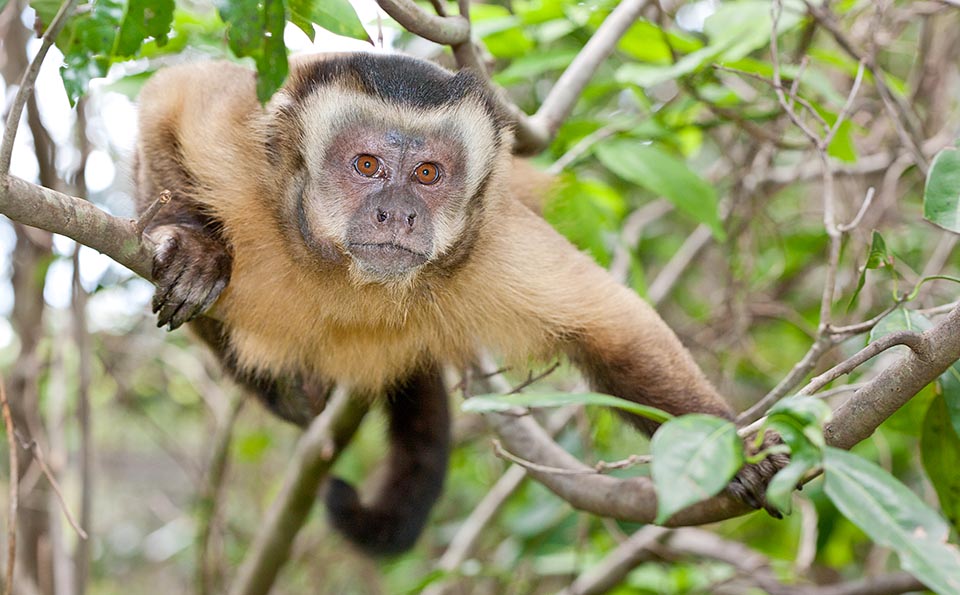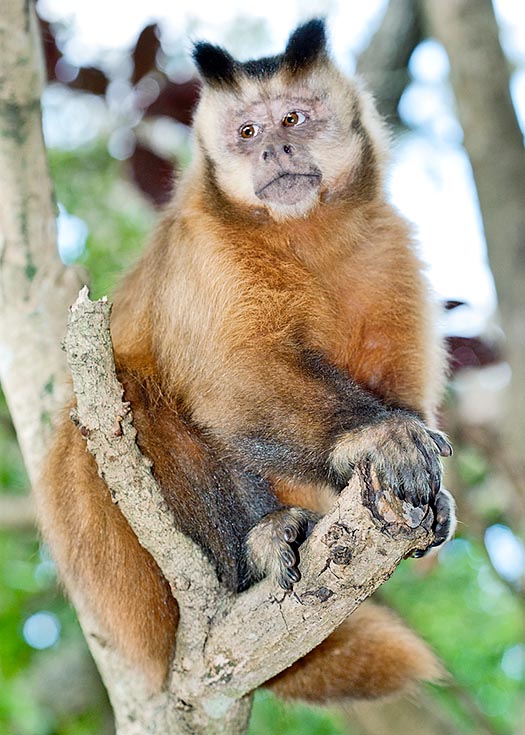Family : Cebidae

Text © Dr. Silvia Foti

English translation by Mario Beltramini

The Tufted capuchin (Sapajus apella) extends from Colombia and Venezuela up to Paraguay and North Argentina © Giuseppe Mazza

A female. On the head we note the typical black tufts, similar to small horns © G. Mazza
A characteristic distinguishing clearly the capuchin monkeys in two groups is based, besides the presence or not of tufts of hair on the top of the head, the so called sagittal crests, also on the different physical conformation between the species.
The capuchin monkeys with the crests (genus Sapajus) are much more robust, having tail, limbs, jaws and skull more massive than the species having no crests (genus Cebus), that appear less robust and more slender, with limbs longer than the first ones. For this reason, they are presently distinguished in robust capuchin monkeys (with the crests, Sapajus) and gracile capuchin monkeys (without them, Cebus).
For what concerns the etymology of the genus Sapajus, this seems to derive from a Latinized version of the name the Brazilian natives of Tupian language (many of them did live close to the Atlantic coast of Brazil) were giving to this primate. The name of the species, finally, apella, might refer in some way to the name of the popular Spartan deliberative assembly (in old Greek Απέλλα), in relation to the social habits of these monkeys which gather in groups.
Zoogeography
The range of the species extends from Colombia and Venezuela up to Paraguay and northern Argentina.
Ecology-Habitat
The tufted capuchins live in the humid tropical and subtropical forests but they may be met also in gallery forests and secondary and disturbed forests. In north-eastern Argentina these monkeys live in the mountain forests at an altitude from the 200 to the 1100 m. They are arboreal quadrupeds and usually they prefer the under-wood and the canopy (the vault of the forest formed by the crowns of the trees) included between the 10 and the 15 metres of height, but often they come to the ground for drinking or eating or for crossing areas with scarce vegetation.

The 40-50 cm long prehensile tail serves to cling the branches and seize objects but, young apart, cannot support this platyrrhine weight © Giuseppe Mazza
They have diurnal habits, with a period of daily activity varying depending on the seasons, and spend most of the day looking and consuming food.

An alpha male leads and watches the group. The females never leave it, but the males, once reached the sexual maturity, often disperse in the wild forest where they join other communities © Giuseppe Mazza
For getting the food, quite often the capuchins implement actions requiring lot of physical energy, such as beating hard nuts, debarking trees, breaking branches or biting coriaceous fruits.
This characteristic has earned them the name of “destructive” foragers; however they are also defined as “extractive” foragers because they are able to take advantage from resources not accessible to most of the other species of monkeys, nourishing of foods contained in hard shells, or protected by thorns. All these activities require complex manipulative activities, skill and precision in the movements.
These capacities shown by the tufted capuchins while looking and obtaining the food are mostly due to the size of their brain, bigger than what expected on the base of the body weight, factor that could explain the construction of “mental maps” for the efficient research of the alimentary resources optimizing energy and time.
Morpho-physiology
The tufted capuchins have a size of 30 to 50 cm, tail excluded.
They present sexual dimorphism in the size and in the morphology of the canines: the adult males weigh, as an average, 3,7 kg and are long averagely 44 cm but the tail, whilst the adult females weigh 2,5 kg and are about 39 cm long.
The tail has a length varying from the 40 to the 50 cm and shows various grades of semi-prehension: they can use for holding an object, for clinging and for supporting the weight of the body (totally, in the case of the kids, or partially, in the case of the adults). In any case, in respect to the prehensile tail of other platyrrhine monkeys, that of the tufted capuchins is shorter, not so flexible and totally covered by hair. They have a colouration going from the pale brown to the mustard yellow and to the black.

Young male while walking with the typical rolled up tail. In the group the male hierarchic system is based on the age. Besides alpha male live various young and sub-adult males, towards whom the dominant is usually rather tolerant, especially when in captivity, allowing them the food access as being often their father © Giuseppe Mazza
The shoulders and the abdomen are paler than the rest of the body, whilst the top of the head characterizes for a spot of black hair, thus giving the sensation of a cap, from which depart two long black whiskers framing the face. Lastly, always on the head, over each ear, develops a tuft of black hair forming the so called sagittal crests. Hands, feet and tail, which is normally kept spirally rolled, are always of a dark colour, either black of brown.

Female’s vocalizations. They are courting the male who often rejects them in a first time © G. Mazza
Ethology-Reproductive biology
The tufted capuchins live in groups of variable dimensions, from a few individuals up to 15-20, depending on the characteristics of the habitat.
Each group is formed by one or more adult males, by various adult females with their kids and by young individuals.
The females belonging to a group usually never leave it: they spend there all the life, surrounded by their own relatives.
Conversely, the males, once reached the sexual maturity tend to abandon the origin group and disperse in the environment looking for new group where to enter.
Inside each group it can always be seen one dominant male and female, with the male occupying the highest hierarchical position, followed by the female.
Obviously, the dominant male is the leader of the whole group: it decides the movements of all the individuals looking for food, to which it is always the first to accede, the beginning and the end of the resting time or the choice of the site where to spend the night.
Last but not least, it is the male preferred by the females, by whom it is courted and with whom takes place the greatest part of the matings.
The masculine hierarchic system is based on the age: frequent are the groups with only one adult male and several subordinate males, often younger and physically smaller than the alpha male. However, the dominant, especially in captivity, usually shows tolerant towards the other male components of the group (usually, it is the father of many of the young and therefore tends to tolerate and protect the young allowing them the access to the food).

Menacing female. The sexual dimorphism manifests especially in the morphology and in the bigger males canine teeth, keeping also in mind their 3,7 kg of weight compared with the 2,7 of the females © Mazza
The female of the tufted capuchin proves sexually “resourceful”, as is the case in many other species of primates where is the female “to make the first move” towards the male, and displays its reproductive condition through a series of decidedly “particular” behaviours that may be subdivided in three phases.
During the first phase the female courts insistently and explicitly the male, following and continuously soliciting it, making it exaggerated smiles, touching it quickly and then running away. Conversely, the male appears to reply avoiding or even aggressing the female in oestrum.
In the second phase, the male surrenders to the advances, tolerating more the physical proximity of the female, until reaching a reciprocal courtship.
In the third and last phase, the male abandons all resistance and the real and proper mating takes place, accompanied by particular vocalizations on the part of both partners.
The reproductive period of the adult females of Sapajus apella, in the wild as well as in captivity, can be observed all over the year. In any case certain seasonality is observed in the births, which seem to happen mostly during spring and summer, period of the year where is standing a greater availability of food due to the abundant presence of fruits.

A young looks and learns. Like chimpanzees the tufted capuchins are in fact very intelligent © G. Mazza
Use of tools
Although much distant from the man on an evolution point of view, the tufted capuchins shows numerous behavioural similarities with the hominids (for instance, the omnivorous diet, the use of tools and the high index of encephalization) and this renders them an interesting model for the study of the evolution of abilities considered as typically human.
In fact, the tufted capuchins are excellent users of tools: they show a tendency to the manipulation that rivals, for many aspects, with that of the chimpanzees.
Thanks to the presence of long limbs, of an excellent control of the posture and of strength sufficient for imparting an adequate pressure on the objects, the tufted capuchins prove able to manipulate them accurately and to position them with precision on the base of the use they make of them. About the use of instruments done by the tufted capuchins a trace is even found, in some writings by Erasmus Darwin, grandfather of the more famous Charles, who reported the news of a tufted capuchins observed in captivity, which, having no teeth, has specialized in opening the nuts by using a stone.

They use stones as hammers and sticks to extract arthropods, honey, wax or water from rocks holes and cracks © Giuseppe Mazza
Moreover, it has been found that they are capable to use tools even much more “demanding”; studies done in Brazil, in the region of the Piauí, have proved that the tufted capuchins are able to select accurately stones for using them as hammers, beating them with force on “anvils”, some big stones, for opening hard fruits and nuts.
Curiosity
A very particular behaviour shown by the tufted capuchins consists in urinating on their own hands and then rubbing them on the palms of the feet and on the tip of the tail (urine washing).
It is not yet very clear what can be the specific meaning of such activity, but this might be in some manner a way through which the males communicate their sexual maturity to the females of the group or a behaviour that is manifested as answer to events or to particularly stressing situations.

Due to its cleverness, prolificity and adaptation to present habitat changes, the Sapajus apella is the most common monkey in the Amazonian forest and unlike most of primates it is not under any risk of extinction © Giuseppe Mazza
This means that presently the Sapajus apella is the most common monkey seen in the Amazon region.
Synonyms
Sapajus apella (Linnaeus, 1758); Cebus apella (Linnaeus, 1758); Cebus capillatus Gray, 1865; Cebus crassiceps Pucheran, 1857; Cebus cristatus G. Cuvier, 1829; Cebus cirrifer E. Geoffroy Saint-Hilaire, 1812; Cebus frontatus Kuhl, 1820; Cebus lunatus Kuhl, 1820; Cebus leucogenys Gray, 1866; Cebus monachus F. Cuvier, 1820; Cebus subcristatus Gray, 1865; Cebus niger E. Geoffroy Saint-Hilaire, 1812; Simia variegata Humboldt, 1812; Cebus apella macro- cephalus Spix, 1823; Cebus apella magnus Pusch, 1941; Cebus apella tocantinus Lönnberg, 1939.
→ For general notions about Primates please click here.
→ To appreciate the biodiversity within the PRIMATES please click here.
